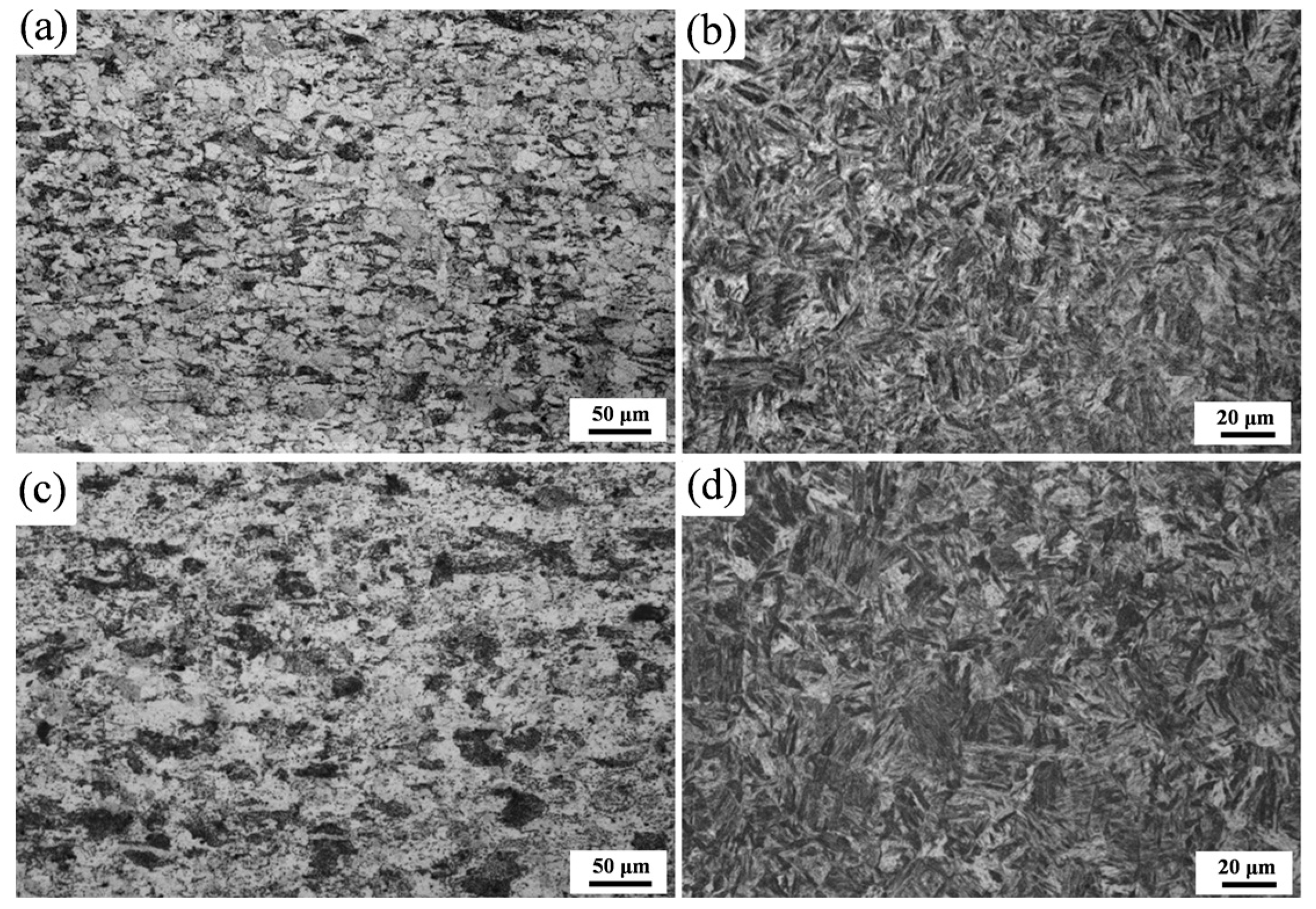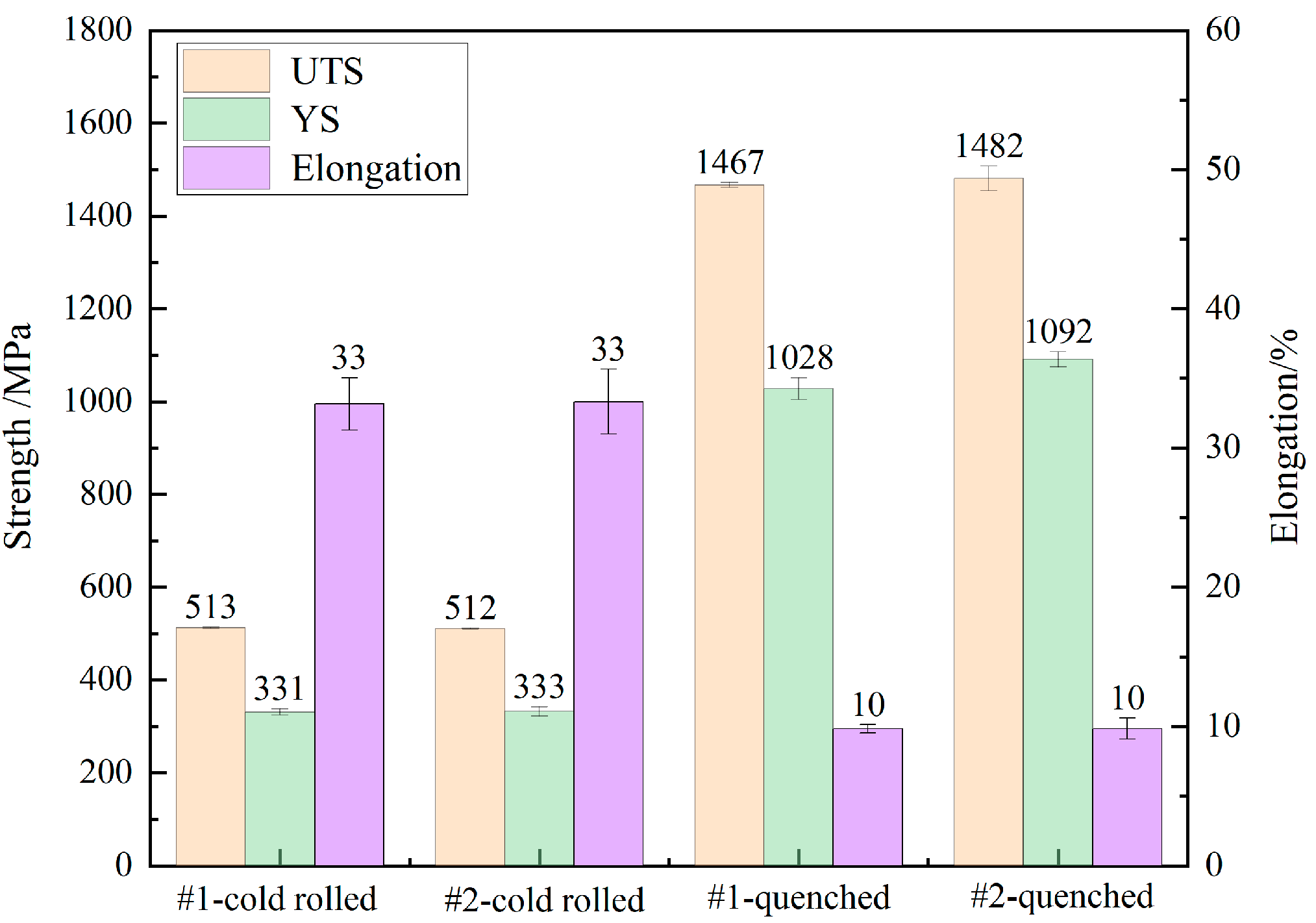Effect of Batch-Annealing Temperature on Oxidation of 22MnB5 Steel during Austenitizing
Abstract
:1. Introduction
2. Materials and Methods
3. Results and Discussion
4. Conclusions
Author Contributions
Funding
Data Availability Statement
Conflicts of Interest
References
- Guo, N.; Zhang, X.; Hou, Z.; Wang, W.; Yang, D.; Min, J.; Ming, P.; Zhang, C. Hot stamping of ultra-thin stainless steel sheets for bipolar plates. J. Mater. Process. Technol. 2023, 317, 117987. [Google Scholar] [CrossRef]
- Gronostajski, Z.; Pater, Z.; Madej, L.; Gontarz, A.; Lisiecki, L.; Lukaszek-Solek, A.; Łuksza, J.; Mróz, S.; Muskalski, Z.; Muzykiewicz, W.; et al. Recent development trends in metal forming. Arch. Civ. Mech. Eng. 2019, 19, 898–941. [Google Scholar] [CrossRef]
- Senuma, T. Hot Stamping Steel. Encycl. Mater. Met. Alloys 2022, 2, 26–36. [Google Scholar]
- Bhadeshia, H.; Honeycombe, R.E. Steels: Microstructure and Properties, 4th ed.; Elsevier Ltd.: Amsterdam, The Netherlands, 2017; pp. 271–301. [Google Scholar]
- Mori, K.; Bariani, P.; Behrens, B.-A.; Brosius, A.; Bruschi, S.; Maeno, T.; Merklein, M.; Yanagimoto, J. Hot stamping of ultra-high strength steel parts. CIRP Ann. 2017, 66, 755–777. [Google Scholar] [CrossRef]
- Li, B.; Chen, Y.; Zhao, X.; Li, J.; Wang, C.; Wang, M. Effect of Austenitization Process on Oxidative Decarbonization Behavior and Mechanical Properties of 22MnB5 Steel. J. Mater. Eng. Perform. 2023, in press. [CrossRef]
- Yao, Z.; Ma, F.; Liu, Q.; Zhao, F.; Li, F.; Lin, J.; Wang, X.; Song, W. High Temperature Oxidation Resistance and Mechanical Properties of Uncoated Uitrahigh-Strength Steel 22MnB5. In Proceedings of the FISITA 2012 World Automotive Congress, Beijing, China, 27 November 2012. [Google Scholar]
- Deng, B.; Yi, H.L.; Wang, G.D. Effect of Mo on high temperature oxidation behavior of 22MnB5 steel sheet during hot stamping. Steel Roll. 2020, 37, 6–11. [Google Scholar]
- Shen, Y.; Ju, Q.; Xu, G.; Du, X.; Zhang, Y.; Zhu, Y.; Huang, J.; Wang, T.; Liu, Z. Improved oxidation resistance and excellent strength of nickel-based superalloy at 1100 °C by determining critical Cr-Al value. Mater. Lett. 2022, 328, 133226. [Google Scholar] [CrossRef]
- Li, F.; Wang, Y.; Dang, W.; Xu, Z.; Zhang, X.; Zhao, K.; Hu, X.; Tang, Y. Polycarbosilane-derived ceramic coatings with crack-free morphology for improving oxidation resistance of steel. Mater. Lett. 2022, 328, 133088. [Google Scholar] [CrossRef]
- Huang, C.-Y.; Chen, Y.; Lin, C.-S. High-temperature oxidation resistance of hot stamping steel with chromium coating electroplated in trivalent chromium bath. Mater. Today Commun. 2022, 33, 104663. [Google Scholar] [CrossRef]
- Chang, J.-K.; Lin, C.-S.; Cheng, W.-J.; Lo, I.-H.; Wang, W.-R. Oxidation resistant silane coating for hot-dip galvanized hot stamping steel. Corros. Sci. 2020, 164, 108307. [Google Scholar] [CrossRef]
- Zhao, Y.; Yang, D.; Qin, Z.; Chu, X.; Liu, J.; Zhao, Z. A novel hot stamping steel with superior mechanical properties and antioxidant properties. J. Mater. Res. Technol. 2022, 21, 1944–1959. [Google Scholar] [CrossRef]
- Mori, K.; Ito, D. Prevention of oxidation in hot stamping of quenchable steel sheet by oxidation preventive oil. CIRP Ann. 2009, 58, 267–270. [Google Scholar] [CrossRef]
- An, L.-Z.; Wang, Y.-P.; Wang, G.-D.; Liu, H.-T. Fabrication of high-performance low silicon non-oriented electrical steels by a new method: Low-finishing-temperature hot rolling combined with batch annealing. J. Magn. Magn. Mater. 2022, 546, 168907. [Google Scholar] [CrossRef]
- Singh, R.K.; Sudharshan, R.; Mehta, P.K.; Chandrawanshi, M.; Mishra, D. Optimization of annealing stack using design of experiment method in Batch Annealed HSLA Steel. Mater. Today Proc. 2018, 5, 7055–7060. [Google Scholar] [CrossRef]
- Kumar, D.; Viswanathan, N.N.; Sarkar, P.S. Heat Transfer Model of Coil in a Bell Annealing Furnace. In Proceedings of Recent Advances in Manufacturing Processes and Systems, Lecture Notes in Mechanical Engineering; Springer: Singapore, 2022. [Google Scholar]
- Tamer, J.; Ozgultekin, G.; Poyraz, O.; Seyalioglu, C. Formability Analyses of a Novel Alloy Cold-rolled Batch Annealed Dual Phase Steel. Procedia Manuf. 2020, 47, 1211–1216. [Google Scholar] [CrossRef]
- Zhao, X.L.; Chen, W.; Zhao, Z.Z.; Wang, S. Effects of Batch Annealing Temperature on Microstructure and Mechanical Properties of 1500 MPa Grade Hot Stamping Steel. Hot Work. Technol. 2022, 51, 149–156. [Google Scholar]
- Tong, C.; Yardley, V.A.; Shi, Z.; Rong, Q.; Li, X.; Zhang, B.; Xu, D.; Lin, J. Investigation of the effect of initial states of medium-Mn steel on deformation behaviour under hot stamping conditions. Mater. Sci. Eng. A 2022, 855, 143914. [Google Scholar] [CrossRef]
- Miadad, S.J.; Venugopalan, T.; Halder, N.; Kumar, B.R. On the Study of Batch Annealing Parameter Optimization for Higher Lankford Value in High Phosphorus Interstitial Free High Strength Steel. J. Mater. Eng. Perform. 2020, 29, 7598–7606. [Google Scholar] [CrossRef]
- Steineder, K.; Krizan, D.; Stadler, M.; Ritsche, S.; Berger, E.; Holtmann, N.; Schnitzer, R.; Schneider, R. Critical Aspects Concerning Large-scale Production of a Batch-annealed Medium-Mn 780 MPa Grade for Automotive Applications. Berg-Huettenmaenn. Monatsh. 2022, 167, 513–516. [Google Scholar] [CrossRef]
- Han, J.; Neupane, S.; Wang, L.; Seyeux, A.; Klein, L.; Zanna, S.; Mercier, D.; Maurice, V.; Marcus, P. Effect of surface preparation by high-temperature hydrogen annealing on the passivation of Ni-20 at.% Cr alloy in sulfuric acid. Electrochim. Acta 2023, 454, 142403. [Google Scholar] [CrossRef]
- González-Leal, J.M.; Gallero, E.; Blanco, E.; del Solar, M.R.; Nuñez, A.; Almagro, J.F. Analysis of the Visual Appearance of AISI 430 Ferritic Stainless Steel Flat Sheets Manufactured by Cool Rolling and Bright Annealing. Metals 2021, 11, 1058. [Google Scholar] [CrossRef]
- Fang, G.; Jin, W.; Pei, G.; Yong, T.; Yang, Y. Analysis to the Application of Hydrogen Bell-Type Annealing Furnace in Baosteel Stainless Steel. In Proceedings of the PRICM: 8th Pacific Rim International Congress on Advanced Materials and Processing, Waikoloa, HI, USA, 4–9 August 2013. [Google Scholar]
- Cui, G.Y.; Wang, Y.; Wang, G. Process optimization and performance analysis of batch annealing for low carbon cold rolled sheet. Steel Roll. 2018, 35, 90–93. [Google Scholar]
- Humphreys, J.; Rohrer, G.S.; Rollett, A. Recrystallization and Related Annealing Phenomena, 3rd ed.; Elsevier Ltd.: Amsterdam, The Netherlands, 2017; pp. 527–567. [Google Scholar]
- Birks, N.; Meier, G.H.; Pettit, F.S. Introduction to the High-Temperature Oxidation of Metals; Cambridge University Press: Cambridge, UK, 2006. [Google Scholar]
- Wang, L.; Jiang, W.-G.; Li, X.-W.; Dong, J.-S.; Zheng, W.; Feng, H.; Lou, L.-H. Effect of Surface Roughness on the Oxidation Behavior of a Directionally Solidified Ni-Based Superalloy at 1100 °C. Acta Met. Sin. (Engl. Lett.) 2015, 28, 381–385. [Google Scholar] [CrossRef]
- Cheng, C.-Q.; Hu, Y.-B.; Cao, T.-S.; Zhang, L.; Zhu, Y.-W.; Zhao, J. Two typical oxidation models on nickel-based superalloys under different initial surface roughness. Corros. Sci. 2020, 176, 108942. [Google Scholar] [CrossRef]
- Platt, P.; Allen, V.; Fenwick, M.; Gass, M.; Preuss, M. Observation of the effect of surface roughness on the oxidation of Zircaloy-4. Corros. Sci. 2015, 98, 1. [Google Scholar] [CrossRef]






Disclaimer/Publisher’s Note: The statements, opinions and data contained in all publications are solely those of the individual author(s) and contributor(s) and not of MDPI and/or the editor(s). MDPI and/or the editor(s) disclaim responsibility for any injury to people or property resulting from any ideas, methods, instructions or products referred to in the content. |
© 2023 by the authors. Licensee MDPI, Basel, Switzerland. This article is an open access article distributed under the terms and conditions of the Creative Commons Attribution (CC BY) license (https://creativecommons.org/licenses/by/4.0/).
Share and Cite
Li, B.; Liu, Y.; Chen, Y.; Li, N.; Zhao, X.; Li, J.; Wang, M. Effect of Batch-Annealing Temperature on Oxidation of 22MnB5 Steel during Austenitizing. Metals 2023, 13, 1011. https://doi.org/10.3390/met13061011
Li B, Liu Y, Chen Y, Li N, Zhao X, Li J, Wang M. Effect of Batch-Annealing Temperature on Oxidation of 22MnB5 Steel during Austenitizing. Metals. 2023; 13(6):1011. https://doi.org/10.3390/met13061011
Chicago/Turabian StyleLi, Bibo, Yanning Liu, Ying Chen, Nan Li, Xiaolong Zhao, Jikang Li, and Maoqiu Wang. 2023. "Effect of Batch-Annealing Temperature on Oxidation of 22MnB5 Steel during Austenitizing" Metals 13, no. 6: 1011. https://doi.org/10.3390/met13061011
APA StyleLi, B., Liu, Y., Chen, Y., Li, N., Zhao, X., Li, J., & Wang, M. (2023). Effect of Batch-Annealing Temperature on Oxidation of 22MnB5 Steel during Austenitizing. Metals, 13(6), 1011. https://doi.org/10.3390/met13061011





